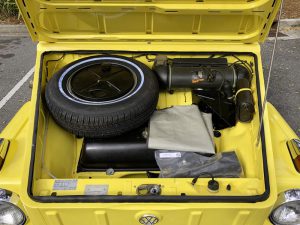AUTO CLASSIC: With the 181 through the USA
If you want to get to know the USA, you should go on a road trip. And if you want to stand out, it’s best to take a car that could hardly be more purist: a Volkswagen 181, also known by the nickname “Kübel”. It celebrated its 50th birthday in 2019. Birthday
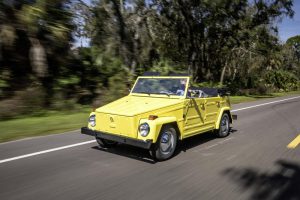
Americans love powerful eight-cylinder engines, bubbling pick-ups, exclusive luxury models from Europe or SUVs. The VW 181, once conceived as an army vehicle under the official name “courier car”, is hardly known outside the sunny states of Florida or California. But anyone who sees it gives it a thumbs-up or calls it by its American nickname, “The Thing”.
The thing – and what a thing it is. The technical basis for the VW 181, which was introduced in 1968 and produced from 1969 onwards, is the Beetle, which is probably an even bigger legend in the USA than in Europe. On top of it – to put it ungallantly – is a corrugated iron body whose beauty is probably only apparent to many at third or fourth glance. The Thing is generally regarded as easy to repair and indestructible. The tank of the classic car holds only 40 litres and so it is often necessary to refuel – despite a comparatively economical consumption of hardly more than ten litres. And because the fuel gauge is just as defective as the odometer, it is refuelled a little more often than it should be.
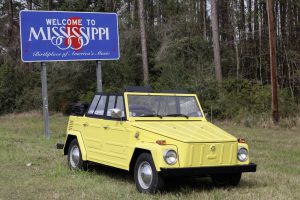
Practical: the PVC roof can be folded back in a few easy steps, because an 181 is usually driven open in all weathers. Then pull the four windows out of their holders and stow them behind the two black leatherette chairs, and off we go in a westerly direction – away from highways and motorways. Because it gets uncomfortable above a speed of 50 miles per hour.
Small roads, great driving pleasure
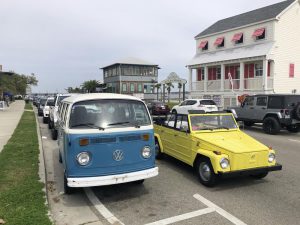
The smaller the road, the greater the riding pleasure. Near the coast, many bikers are on the road and the 1.6-litre four-cylinder boxer cackles away cheerfully. Harley riders on their rumbling two-cylinders look irritatedly over at the yellow Thing. They laugh and nod. Even when they see that the two aluminium cases on the back seat are secured with bicycle locks.
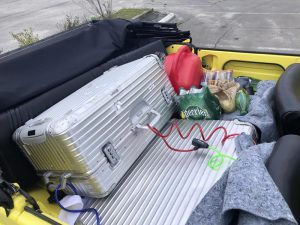
The same picture at stops at petrol stations, nameless supermarkets and rest areas near the coast. At the Fathoms Steam Room in Apalachicola, the fish portions are stately. The owner of the restaurant comes rushing forward from the kitchen and asks who owns the yellow Thing, she has never seen one before. Minutes later, her boyfriend arrives and wants to buy it. The next day, we continue towards Pensacola, passing one of the largest flight schools in the US. A hurricane named “Michael” raged here at the beginning of October 2018. Destroyed houses and mown-down forests can be seen for hours along the coastal road.
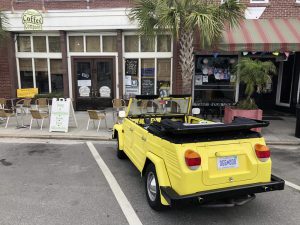
It is no longer as hot as on the first day, only ten degrees Celsius. The coast seems deserted, it is foggy. A functioning heating system is just as much missed as comfortable seats. The practical thing is that anyone who spills on the plastic chairs during sandwich or coffee breaks simply wipes them off.
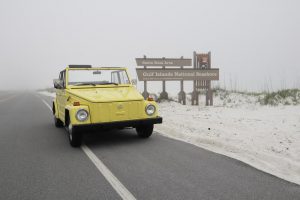
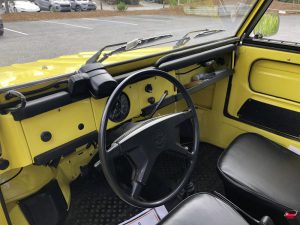
You won’t find any mountains here. But when it comes to big bridges, the 1.6-litre boxer engine in the rear struggles and pushes the car with its manageable 32 kW / 44 hp up the steep river crossings. On small back roads or on the highway, the yellow utility vehicle from 1973 still manages a little more than 60 miles per hour, which corresponds to about 97 kilometres per hour. Officially, its maximum speed is just over 70 miles.
A kind of automotive voodoo
We drive through the swamps of the southern states towards New Orleans in the direction of the gigantic Mississippi Delta – always along the never-ending coastline and waterline, where sea and lakes can hardly be distinguished.
In New Orleans, the colourful heart of Louisiana, there is a party every night. While the paddle steamer Steamer Natchez sails off into the setting sun, the colourful nightlife is buzzing around Bourbon Street.
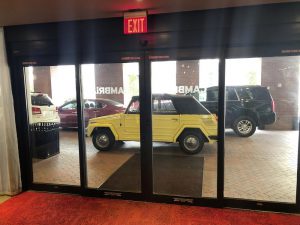
But even among the pleasure-seeking tourists and local partygoers, The Thing stands out. One or the other thinks it is an automotive kind of voodoo in the New Orleans delirium. The hotel’s car attendant leaves the 181 parked right in front of the main entrance: No one here wants to drive a manual transmission. This guarantees attention and unusually quick access to the vehicle.
The next day we continue through endless swamplands with alligators. I drive off highway 90 in the direction of Erath Abbeyville before turning onto highway 82. When the bucket runs out in no man’s land of Louisiana with a spot right in front of Booth’s Grocery near Grand Chenier, I meet the owner Temea:
“I’ve had the shop here since 1957,” says the sprightly senior citizen, immediately offering the local speciality, a sausage and rice mix.
Celebrating at the end of the day
After filling up with the spare can, it turns out: the tank was not empty at all, but after almost 1,000 miles (about 1,600 kilometres) of driving, the fuel pump had given out. Two hours later it’s working again and so, with a gentle throttle and attentive ears, we continue on the 82 to Lake Charles, 60 miles away, where those who think Las Vegas is too far away party in one of the big casinos.
I don’t choose the direct route to the end of the journey in Houston, but head south along the coastline via Highway 27 to 82. On the final stage, the old car is celebrated once more in the after-work traffic: The yellow oddity stands out even more here than in the southern states.
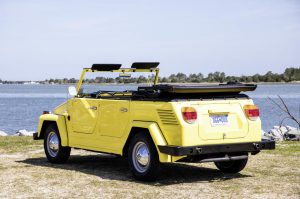
BRAND: Volkswagen AG
virtualdesignmagazine Michael Hiller


